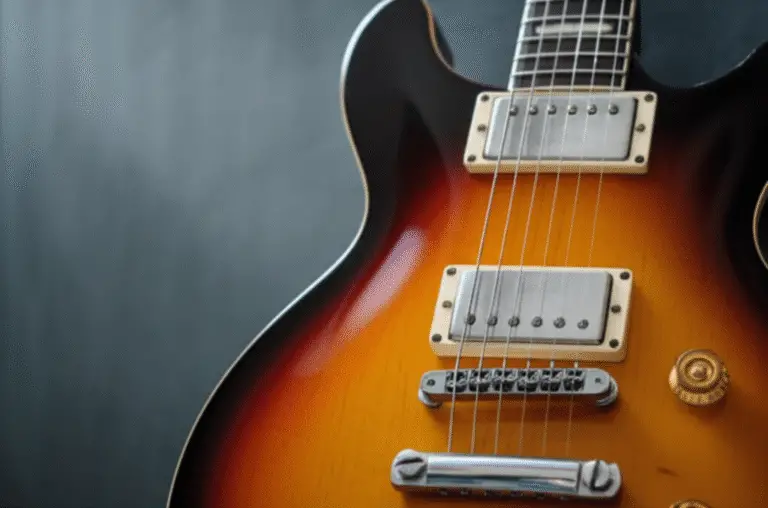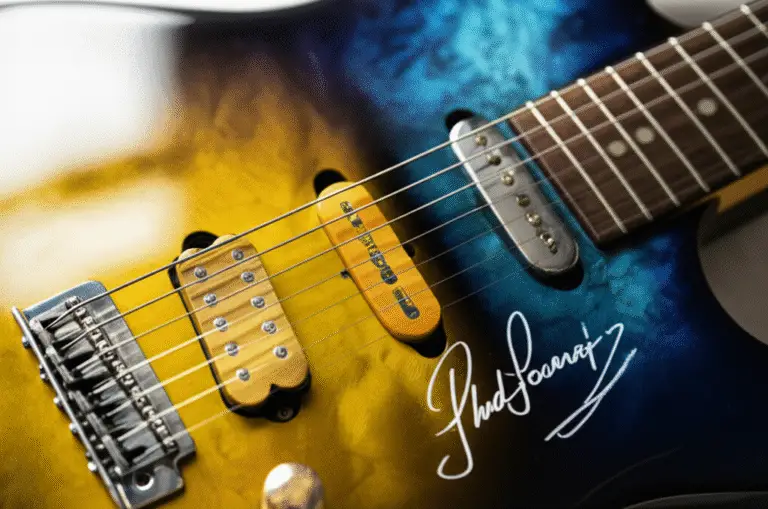Support our educational content for free when you purchase through links on our site. Learn more
How to Choose the Right Guitar Brand for Your Playing Style 🎸 (2025)
Choosing the perfect guitar brand can feel like navigating a labyrinth of wood, strings, and pickups. Whether you’re chasing the searing solos of rock legends or the warm, mellow tones of folk ballads, the brand you pick can shape your sound and inspire your playing for years to come. Did you know that the subtle differences in tonewoods, neck shapes, and pickup configurations across brands can dramatically influence your comfort and creativity? Stick around as we unpack everything—from iconic giants like Fender and Gibson to boutique innovators and acoustic legends like Taylor and Martin—to help you find the guitar brand that truly sings to your style.
Later, we’ll dive deep into how your genre, skill level, and budget intersect with brand choices, plus insider tips on testing guitars in-store and navigating warranties and financing. Ready to find your sonic soulmate? Let’s strum into it!
Key Takeaways
- Your playing style and genre are the compass for choosing the right guitar brand—blues players might lean Fender, while metalheads often prefer Ibanez or ESP.
- Body shape and tonewoods matter: They influence comfort and tone, so understanding these helps narrow your options.
- Skill level guides your brand choice: Beginners thrive with brands like Squier and Epiphone, while pros gravitate toward American-made Fender, Gibson, and boutique models.
- Try before you buy: Hands-on testing is essential to find a guitar that feels like an extension of you.
- Consider after-sales support and warranty: Brands like Taylor offer stellar warranties and customer service, protecting your investment.
- Financing options can help you afford a better guitar sooner, accelerating your musical growth.
Ready to explore the best guitar brands tailored to your unique style? Dive into our comprehensive guide and find your perfect match!
Table of Contents
- ⚡️ Quick Tips and Facts on Choosing the Right Guitar Brand
- 🎸 The Evolution of Guitar Brands: A Brief History and Industry Insights
- 🎯 Understanding Your Playing Style: The Key to Picking the Perfect Guitar Brand
- 🔍 1. Top Guitar Brands and Their Signature Styles: Who Makes What?
- 🎸 2. How Guitar Body Shapes and Woods Influence Your Sound and Brand Choice
- 🎯 3. Skill Level Matters: Choosing a Brand That Grows With You
- 💡 4. Budgeting Smart: Getting the Best Value From Your Guitar Brand
- 🏪 Find Your Next Guitar Locally: Tips for Testing and Buying In-Person
- 🛠️ Service and Support: Why After-Sales Care Should Influence Your Brand Choice
- 💳 Financing Your Dream Guitar: How to Maximize Your Purchase Power
- 🎶 New Riffs: Emerging Guitar Brands and Trends to Watch
- 🌲 Tonewoods and Body Shapes: Matching Materials to Genres and Playing Styles
- 🎤 How to Choose the Right Guitar Brand for Your Genre: Rock, Blues, Jazz, Country, and More
- 🎸 Brand Spotlight: What Makes Taylor Guitars a Favorite Among Players?
- 🎯 Choosing the Right Taylor Guitar for Your Playing Style and Skill Level
- 🇺🇸🇲🇽 Taylor’s U.S.-Made vs. Mexico-Made Guitars: What You Need to Know
- 👶 How Taylor Supports First-Time and Younger Players
- 🛡️ Taylor’s Warranty and Service Process: Peace of Mind for Your Investment
- 🤝 Become a Taylor Insider: Benefits and Community Perks
- 📱 Connect With Us: Guitar Brands™ Community and Support Channels
- 🔚 Conclusion: Strum Your Way to the Perfect Guitar Brand Match
- 🔗 Recommended Links for Guitar Brand Research and Purchase
- ❓ FAQ: Your Burning Questions on Choosing Guitar Brands Answered
- 📚 Reference Links and Further Reading
Howdy, fellow tone chasers! Welcome to the Guitar Brands™ lounge, where we spill the tea on everything with six strings (and sometimes four or seven!). Choosing the right guitar brand is like finding your musical soulmate—it’s a deeply personal journey. We’re here to be your trusty wingmen, guiding you through the vast world of headstocks and humbuckers to find the one.
Ready to dive in? Let’s get this show on the road!
⚡️ Quick Tips and Facts on Choosing the Right Guitar Brand
Before we get lost in the woods (the tonewoods, that is!), here are some rapid-fire tips to get your brain buzzing.
- Your Heroes Know Best: Check out what your favorite guitarists play. Their brand choice is often a great starting point for finding a sound you love.
- Feel is Everything: A guitar should feel like an extension of your body. If it’s uncomfortable, you won’t want to play it, no matter how cool it looks. As one expert puts it, “If you find a guitar that feels and sounds great to you, it’s probably the one that will encourage you to play the most.”
- There’s No “Best” Brand: Sorry to burst that bubble! The “best” brand is entirely subjective and depends on your style, budget, and personal taste.
- Try Before You Buy: We can’t stress this enough. Go to a local shop and get your hands on as many different guitars as possible. You might be surprised by what clicks.
- Budget Brands are Awesome: Don’t sleep on brands like Squier and Epiphone. They offer incredible value and are fantastic starting points for any player.
| Quick Facts Table | Details |
|---|---|
| Most Popular Beginner Brands | Squier, Epiphone, Yamaha |
| Iconic Electric Guitar Rivalry | Fender vs. Gibson |
| Acoustic Titans | Martin, Taylor |
| Metal & Shred Mainstays | Ibanez, Jackson, ESP |
| Key to Comfort | Neck Shape, Body Size, and “Action” (string height) |
🎸 The Evolution of Guitar Brands: A Brief History and Industry Insights
Ever wonder how we got from simple stringed instruments to the sonic beasts we have today? The history of guitar brands is a wild ride full of innovation, rivalry, and rock and roll!
It all started with acoustic pioneers like C.F. Martin & Company, founded way back in 1833. They basically wrote the book on the American acoustic guitar, introducing game-changing designs like the Dreadnought and X-bracing that are still the standard today.
Then, in the early 20th century, a little company called Gibson (founded in 1902) started making waves, first with archtop guitars and then, crucially, with the electric guitar. The race was on! In the 1950s, Fender crashed the party with the revolutionary solid-body Telecaster and Stratocaster, changing music forever. This sparked one of the greatest rivalries in music history—the smooth, thick tones of a Gibson Les Paul versus the bright, snappy sound of a Fender Strat.
The latter half of the century saw an explosion of new brands. Japanese companies like Ibanez and Yamaha brought incredible quality and innovation, especially for rock and metal players. More recently, brands like PRS (Paul Reed Smith) have carved out a space by blending the best of vintage design with modern precision.
This rich history is why we have such an incredible variety of instruments today. Each brand has a story and a signature sound, shaped by the artists who played them and the eras they defined. For a deeper dive, check out our Guitar Brand Guides.
🎯 Understanding Your Playing Style: The Key to Picking the Perfect Guitar Brand
Okay, let’s get personal. What kind of player are you? Or what kind do you want to be? Answering this is the single most important step in finding the right brand. “Playing style” isn’t just about genre; it’s a mix of several things:
- Genre: Are you a blues-wailing purist, a metal-shredding maniac, a country-picking virtuoso, or a gentle folk strummer? Different brands are stereotypically associated with certain genres for a reason—their instruments are built to excel at those sounds.
- Technique: Do you play with a heavy hand or a light touch? Do you bend strings like a madman or prefer intricate fingerpicking? A guitar’s setup, especially its scale length, can make these techniques easier or harder.
- Role in the Band: Are you the lead guitarist, cutting through the mix with searing solos? Or are you the rhythm player, laying down a solid foundation? This can influence whether you need single-coil pickups for clarity or humbuckers for power.
Think of it like this: a Fender Stratocaster, with its bright single-coil pickups, is like a nimble sports car—perfect for weaving intricate blues and funk lines. A Gibson Les Paul, with its powerful humbuckers and mahogany body, is more like a muscle car—built for roaring rock and roll power chords.
But don’t get boxed in! As the featured video in this article wisely points out, “You can play anything on anything.” These are just starting points. The real magic happens when you find the brand that inspires you.
🔍 1. Top Guitar Brands and Their Signature Styles: Who Makes What?
Let’s meet the key players. We’ve broken them down into the big categories to help you navigate the landscape.
Electric Guitar Giants: Fender, Gibson, PRS, and More
These are the brands that defined the sound of the electric guitar.
| Brand | Signature Models | Best For Genres | Key Characteristics |
|---|---|---|---|
| Fender | Stratocaster, Telecaster | Rock, Blues, Indie, Country, Funk | Bright, articulate, “snappy” tones; versatile; often feature single-coil pickups and bolt-on necks. |
| Gibson | Les Paul, SG, ES-335 | Rock, Jazz, Metal, Blues | Warm, thick, powerful tones; great sustain; typically use humbucker pickups and set necks. |
| PRS | Custom 24, SE Series | Rock, Blues, Jazz | Blends Fender and Gibson traits; known for high-quality craftsmanship, beautiful finishes, and versatility. |
| Ibanez | RG, S Series | Metal, Hard Rock, Jazz | Fast, thin necks perfect for shredding; innovative designs; often feature high-output pickups. |
👉 Shop Electric Guitar Brands on:
- Fender: Amazon | Guitar Center | Sweetwater
- Gibson: Amazon | Guitar Center | Sweetwater
- PRS: Amazon | Guitar Center | Sweetwater
- Ibanez: Amazon | Guitar Center | Sweetwater
Acoustic Legends: Martin, Taylor, Yamaha, and Others
For those who prefer to play unplugged, these are the names to know in the world of Acoustic Guitars.
| Brand | Signature Models | Best For Genres | Key Characteristics |
|---|---|---|---|
| Martin | D-28, 000-18 | Folk, Bluegrass, Singer-Songwriter | The quintessential American acoustic sound; rich, warm, and powerful with deep bass. |
| Taylor | 814ce, GS Mini | Pop, Country, Worship, Fingerstyle | Modern, bright, and balanced tone; known for exceptional playability and consistency. |
| Yamaha | FG800, APX Series | All Genres | Incredible value and reliability; known for making high-quality instruments at every price point. |
| Gibson | J-45, Hummingbird | Rock, Blues, Country | “Workhorse” guitars with a distinctive dry, thumpy, and mid-rangy tone that records beautifully. |
👉 Shop Acoustic Guitar Brands on:
- Martin: Amazon | Guitar Center | Sweetwater
- Taylor: Amazon | Guitar Center | Sweetwater
- Yamaha: Amazon | Guitar Center | Sweetwater
Boutique and Custom Brands: When Exclusivity Meets Tone
For players seeking the ultimate in craftsmanship and unique features, boutique brands offer a personalized experience. Luthiers at companies like Collings, Santa Cruz, and Suhr build instruments with meticulous attention to detail. While they come with a higher price tag, they represent the pinnacle of guitar making.
🎸 2. How Guitar Body Shapes and Woods Influence Your Sound and Brand Choice
Ever wonder why a Stratocaster looks and sounds so different from a Les Paul? A huge part of it comes down to two things: body shape and tonewoods.
The woods used in a guitar have a massive effect on its sound. For example, mahogany provides a warm, woody tone with a strong midrange, which is a key ingredient in the classic Gibson sound. In contrast, the alder or ash bodies often used by Fender contribute to their brighter, more resonant character.
Body shape is just as crucial. A big, bold acoustic Dreadnought (pioneered by Martin) is a cannon, perfect for powerful strumming. A smaller Grand Concert body, a Taylor specialty, is more focused and articulate, ideal for fingerstyle playing.
On the electric side, the contoured body of a Fender Stratocaster is designed for comfort, while the single-cutaway, carved-top design of a Gibson Les Paul offers massive sustain. The shape isn’t just for looks—it affects how the guitar balances, feels against your body, and resonates.
🎯 3. Skill Level Matters: Choosing a Brand That Grows With You
Whether you’re a total newbie or a seasoned pro, there’s a brand out there for you.
For the Beginner ✅
Welcome! The most important thing for a first guitar is that it’s easy and inspiring to play. You don’t need to break the bank. Brands like Squier (by Fender), Epiphone (by Gibson), and Yamaha are the undisputed champions here. They make affordable, reliable instruments that look, feel, and sound like their more expensive siblings.
Many of these brands offer “starter packs” that include everything you need: the guitar, a small amp, a cable, a strap, and picks. It’s a fantastic way to get everything at once.
Top Beginner Picks:
- Electric: Squier Stratocaster Pack, Epiphone Les Paul Player Pack
- Acoustic: Yamaha FG800, Fender FA-125
For the Intermediate Player ↗️
You’ve got the basics down, and you’re starting to develop your own voice. It’s time for an upgrade! At this stage, you can look at more specialized instruments. Maybe you started on a Strat-style guitar and now you want the thick, heavy sound of a guitar with humbuckers.
Brands like Fender’s Player Series, PRS’s SE line, and the upper ranges of Epiphone and Ibanez offer professional features and build quality without the custom shop price tag.
For the Advanced/Professional Player 🏆
You know exactly what you want in an instrument. This is where the flagship lines from major brands shine: Fender American Professional II, Gibson Original Collection, and PRS Core models. You’re paying for premium woods, top-tier electronics, and impeccable craftsmanship. This is also the territory of the boutique and custom shop brands we mentioned earlier.
💡 4. Budgeting Smart: Getting the Best Value From Your Guitar Brand
Let’s talk money. While we don’t list specific prices (they change too often!), we can talk about value. A reputable brand name often ensures a certain level of quality, playability, and durability.
Here’s a general breakdown of what to expect:
- Entry-Level (Beginner): This is the realm of Squier, Epiphone, Yamaha, and other great brands like Donner and Harley Benton. You can get a fantastic, playable instrument that will last you for years.
- Mid-Range (Intermediate): Here you’ll find guitars made in places like Mexico (Fender Player Series) or Indonesia/Korea (PRS SE, Ibanez, Schecter). The quality jumps up significantly with better hardware, pickups, and woods.
- High-End (Professional): These are typically American-made instruments from Fender, Gibson, Martin, and Taylor. You’re paying for the best materials, skilled labor, and the brand’s legacy.
Pro Tip: A “setup” is crucial! Even a budget guitar can feel amazing with a professional setup, which involves adjusting the string height (action), intonation, and neck relief. It’s the best investment you can make in any guitar.
🏪 Find Your Next Guitar Locally: Tips for Testing and Buying In-Person
Reading reviews is great, but nothing beats hands-on experience. As Taylor Guitars advises, “Go to a shop and play a wide variety of acoustic guitars.” This is the only way to truly know what fits you.
Here’s what to do when you’re at the store:
- Hold It: Does it feel comfortable sitting and standing? Is it too heavy? Can you reach the whole fretboard easily?
- Check the Neck: Run your hand up and down the neck. Is it smooth? Does the shape (the “profile”) feel good in your hand? Some are thin and flat (“C” shape), while others are chunkier (“U” or “V” shape).
- Play It (Even if You “Can’t” Play): Don’t be shy! Even if you only know a few chords, strum them. Play single notes up and down the neck. Does it sound good to you?
- Look for a Straight Neck: Look down the neck from the headstock to the body. It should be nearly straight, with a very slight upward curve.
- Check the Action: The strings shouldn’t be miles away from the fretboard, as that makes it hard to play.
- Test the Electronics: If it’s an electric or acoustic-electric, plug it in! Turn all the knobs and flip all the switches to make sure they work without crackling.
🛠️ Service and Support: Why After-Sales Care Should Influence Your Brand Choice
A guitar is an investment, and a good brand stands behind its product. A manufacturer’s warranty is a sign of confidence in their craftsmanship.
- Warranty: Most major brands offer a warranty, but the terms can vary. For example, Fender offers a two-year warranty, while brands like Martin and Taylor are known for their excellent lifetime coverage for the original owner. This typically covers manufacturing defects, not wear and tear or damage from neglect (like leaving your guitar in a hot car!).
- Customer Service: How does the company handle issues? Brands with a strong reputation, like Taylor, are often praised for going above and beyond to help their customers.
- Authorized Service Centers: Reputable brands have a network of authorized repair technicians. This means if you have a warranty issue, you can take it to a local expert who knows the instrument inside and out.
Don’t overlook this! A great warranty and support system provide peace of mind and protect your investment for years to come.
💳 Financing Your Dream Guitar: How to Maximize Your Purchase Power
Sometimes, the perfect guitar is just a little out of immediate reach. Don’t let that stop you! Most major music retailers like Guitar Center and Sweetwater offer financing plans. These can be a fantastic way to get a higher-quality instrument now and pay for it over time, often with no interest if paid within a certain period.
This can be a smart move, especially when upgrading to an intermediate or professional-level guitar. Getting a better instrument can be incredibly inspiring and accelerate your progress as a player. Just be sure to read the terms and make your payments on time!
🎶 New Riffs: Emerging Guitar Brands and Trends to Watch
While the legacy brands are incredible, the guitar world is always evolving. Keep an eye on these exciting trends and brands:
- Strandberg: Known for their innovative, ergonomic, and headless designs, these guitars are built for comfort and modern playing styles.
- Chapman Guitars: A brand born from the internet (founded by YouTuber Rob Chapman), they focus on community-driven designs and offer incredible features for the price.
- Reverend Guitars: This US-based company has a cult following for its unique retro-cool designs, high-quality components (like locking tuners and custom pickups), and artist collaborations.
- Ergonomics and Extended Range: More and more brands are focusing on player comfort with features like multi-scale (fanned-fret) fingerboards, especially on 7- and 8-string guitars designed for modern metal.
🌲 Tonewoods and Body Shapes: Matching Materials to Genres and Playing Styles
Let’s geek out a bit more on the ingredients that make up a guitar’s sonic recipe. The combination of woods and shape is where a brand truly defines its voice.
| Tonewood | Typical Use | Sonic Characteristics |
|---|---|---|
| Mahogany | Back/Sides, Necks, Bodies | Warm, woody, strong midrange, good sustain. A Gibson staple. |
| Rosewood | Back/Sides, Fretboards | Rich, complex overtones with deep lows and sparkling highs. A Martin favorite. |
| Maple | Necks, Fretboards, Tops | Bright, snappy, and clear with great note definition. Key to the Fender sound. |
| Spruce | Acoustic Tops | The standard for acoustic tops; powerful, clear, and dynamic. |
| Koa | Acoustic Tops, Back/Sides | Beautiful grain; starts bright and opens up over time to a warmer, sweeter tone. Often used by Taylor. |
🎤 How to Choose the Right Guitar Brand for Your Genre: Rock, Blues, Jazz, Country, and More
While any guitar can play any genre, some are just a natural fit. Here are our team’s go-to recommendations:
- Rock 🤘: For classic rock, you can’t go wrong with a Gibson Les Paul or SG for thick, powerful riffs. For more modern or versatile rock, a Fender Stratocaster or a PRS Custom 24 is a perfect choice.
- Blues 🎸: The Fender Stratocaster is king here, used by legends from Stevie Ray Vaughan to Eric Clapton. For the warmer, fatter tones of Chicago blues, a semi-hollow body like the Gibson ES-335 is iconic.
- Metal 🤘: Ibanez, Jackson, and ESP dominate this world. Their thin necks, high-output humbuckers, and often aggressive body shapes are built for speed and high-gain distortion.
- Country 🤠: The bright, twangy sound of the Fender Telecaster is the voice of modern country music. For acoustic country and bluegrass, a Martin Dreadnought is the undisputed champion.
- Jazz 🎷: The warm, mellow tones of a hollow-body or semi-hollow guitar are the standard. Look to brands like Gibson (ES-175, L-5), Ibanez (Artcore series), and Gretsch.
- Folk/Singer-Songwriter 🎤: An acoustic guitar is your best friend here. Martin, Taylor, and Gibson acoustics are all fantastic choices, each with a slightly different flavor.
🎸 Brand Spotlight: What Makes Taylor Guitars a Favorite Among Players?
Founded in 1974, Taylor Guitars is a relative newcomer compared to Martin or Gibson, but they’ve had a massive impact. What’s their secret sauce?
- Playability: Taylor is famous for its comfortable, slender neck profiles. They are designed to be easy on the hands, which is a huge plus for beginners and experienced players alike.
- Consistency: Using a blend of modern technology and hand-craftsmanship, Taylor produces incredibly consistent instruments. When you pick up a Taylor, you know you’re getting a high-quality guitar.
- Modern Tone: The “Taylor sound” is often described as bright, balanced, and clear. It’s a very modern acoustic tone that records beautifully and sits well in a mix, making it popular in pop, country, and worship music.
- Innovation: From their bolt-on neck design to their V-Class bracing, Taylor is always pushing the boundaries of acoustic guitar design to improve sound and playability.
🎯 Choosing the Right Taylor Guitar for Your Playing Style and Skill Level
Taylor makes it easy to find your fit with a range of body shapes and wood pairings.
- For Strummers: The Grand Auditorium (their signature shape, found on models ending in “14,” like the 814ce) is the ultimate all-rounder. The classic Dreadnought is also a great choice for powerful volume.
- For Fingerstyle Players: The smaller Grand Concert (models ending in “12”) offers a more focused, articulate sound that’s perfect for intricate playing.
- For Travelers & Beginners: The GS Mini is a phenomenon. It’s a scaled-down guitar that delivers a huge sound for its size, making it incredibly popular for its comfort and portability. The Academy Series is specifically designed for new players, with features like a built-in armrest for extra comfort.
🇺🇸🇲🇽 Taylor’s U.S.-Made vs. Mexico-Made Guitars: What You Need to Know
Taylor operates two factories: one in El Cajon, California, and one in Tecate, Mexico. So, what’s the difference?
- Mexico Factory (Tecate): This is where the more affordable lines are made, including the Academy Series, 100 Series, 200 Series, and the beloved GS Mini and Baby Taylors. These guitars typically feature a solid wood top with layered back and sides. The quality control is exceptional, offering the signature Taylor playability at a more accessible price point.
- USA Factory (El Cajon): This is home to the 300 Series and up. These guitars are built with all-solid woods, which produces a richer, more complex tone that improves with age. They also feature more advanced craftsmanship, higher-end appointments like detailed inlays, and Taylor’s innovative V-Class bracing.
Is one “better”? The US-made guitars are objectively higher-end instruments. But the Mexican-made Taylors offer incredible value and are fantastic guitars in their own right.
👶 How Taylor Supports First-Time and Younger Players
Taylor is particularly welcoming to new guitarists.
- The Academy Series: This line was designed from the ground up for beginners. They feature that famous easy-playing neck, a slightly shorter scale length to reduce string tension, and even a built-in armrest to make playing more comfortable.
- Small-Scale Guitars: The Baby Taylor (3/4 size) and GS Mini are perfect for younger players or anyone with a smaller frame, making the instrument physically easier to manage.
🛡️ Taylor’s Warranty and Service Process: Peace of Mind for Your Investment
As mentioned, Taylor’s warranty is a huge selling point. They offer a limited lifetime warranty to the original owner, covering any defects in materials or workmanship. Their customer service is legendary in the industry. If you have an issue, you can work with their network of authorized service centers to get your guitar playing perfectly again. This commitment to their customers is a major reason why so many players are loyal to the brand.
🤝 Become a Taylor Insider: Benefits and Community Perks
For the true Taylor aficionado, becoming an “insider” offers a deeper connection to the brand. By signing up on their website, you get access to:
- Wood&Steel: Their award-winning quarterly magazine, filled with stories about new guitars, artist interviews, and guitar-making insights.
- Exclusive News: Be the first to know about new model releases and special events.
- A Vibrant Community: Connect with other Taylor players and share your passion for these fantastic instruments.
📱 Connect With Us: Guitar Brands™ Community and Support Channels
Have more questions? Want to show off your new axe? Join the conversation! At Guitar Brands™, we’re more than just a publication; we’re a community of passionate players. Follow us on our social channels and join our forums to connect with our team of experts and fellow guitar lovers. Whether you need buying advice or just want to talk tone, we’re here for you.
🔚 Conclusion: Strum Your Way to the Perfect Guitar Brand Match
Choosing the right guitar brand for your playing style isn’t just a purchase—it’s the start of a lifelong musical journey. From the bright twang of a Fender Stratocaster to the warm embrace of a Gibson Les Paul, or the modern clarity of a Taylor acoustic, each brand offers a unique voice and feel that can inspire your creativity.
We’ve seen how playing style, skill level, budget, and tonal preferences all play crucial roles in this decision. Remember, there’s no one-size-fits-all “best” guitar brand—only the one that feels like it was made for you. Whether you’re a beginner looking for a reliable starter from Squier or Yamaha, or a seasoned pro hunting for a boutique gem or a high-end Taylor, the key is to try before you buy and trust your instincts.
If you’ve been wondering about the difference between Taylor’s U.S.- and Mexico-made guitars, now you know: both offer excellent quality, but the U.S. models bring premium woods and craftsmanship, while the Mexican-made lines deliver outstanding value and playability. And if you’re a first-time player, Taylor’s Academy Series and smaller models like the GS Mini are designed to make your first steps comfortable and inspiring.
So, what’s the final note? Go to a store, play a bunch of guitars, and pick the one that makes you want to play every day. That’s the guitar brand that’s right for you. Ready to find your perfect match? 🎸✨
🔗 Recommended Links for Guitar Brand Research and Purchase
👉 CHECK PRICE on:
- Fender Electric Guitars: Amazon | Guitar Center | Sweetwater | Fender Official Website
- Gibson Electric Guitars: Amazon | Guitar Center | Sweetwater | Gibson Official Website
- PRS Guitars: Amazon | Guitar Center | Sweetwater | PRS Official Website
- Ibanez Guitars: Amazon | Guitar Center | Sweetwater | Ibanez Official Website
- Martin Acoustic Guitars: Amazon | Guitar Center | Sweetwater | Martin Official Website
- Taylor Guitars: Amazon | Guitar Center | Sweetwater | Taylor Official Website
- Yamaha Acoustic Guitars: Amazon | Guitar Center | Sweetwater | Yamaha Official Website
Recommended Books on Amazon:
- Guitar Player Repair Guide by Dan Erlewine — Your go-to for guitar maintenance and setup.
- The Guitar Handbook by Ralph Denyer — A comprehensive guide covering guitar history, styles, and techniques.
- The Art of Guitar by Greg Fessler — Beautifully illustrated, great for inspiration and learning about guitar design.
❓ FAQ: Your Burning Questions on Choosing Guitar Brands Answered
What factors should I consider when selecting a guitar brand?
When choosing a guitar brand, consider your playing style, preferred genres, skill level, budget, and physical comfort. Also, factor in the brand’s reputation for quality, warranty, and after-sales support. Neck shape, body size, and tonewoods are critical for comfort and sound. Trying guitars in person is essential to find the right fit.
How do different guitar brands cater to various playing styles?
Brands design guitars with specific playing styles in mind. For example, Fender guitars with single-coil pickups excel in bright, articulate tones ideal for blues and funk, while Gibson humbuckers provide thick, warm sounds favored in rock and metal. Brands like Taylor focus on playability and balanced acoustic tones, perfect for fingerstyle and singer-songwriters.
Which guitar brands are best for beginners versus advanced players?
For beginners, brands like Squier, Epiphone, and Yamaha offer affordable, reliable instruments that are easy to play. Intermediate players might upgrade to Fender Player Series, PRS SE, or mid-level Ibanez models. Advanced players often choose American-made Fender, Gibson, Martin, or boutique brands for superior craftsmanship and tone.
How does the type of music influence the choice of guitar brand?
Different genres favor certain tonal characteristics. For example, country players often prefer the twangy brightness of a Fender Telecaster, while jazz musicians gravitate toward hollow-body Gibson or Gretsch guitars for warm, mellow tones. Metal players seek brands like Ibanez or ESP for fast necks and high-output pickups.
What are the top guitar brands recommended for fingerstyle players?
Fingerstyle players benefit from guitars with clear articulation and balanced tone. Taylor (especially Grand Concert and GS Mini models) and Martin (000 and OM body shapes) are top choices. Their designs emphasize clarity, responsiveness, and comfort for intricate playing.
How can I test a guitar brand to see if it suits my playing style?
Visit a local music store and play multiple guitars from different brands. Assess comfort by holding and playing chords or scales. Listen for tonal qualities that inspire you. Check neck profile, action, and body size. Don’t hesitate to ask store staff for recommendations or a professional setup.
What are the differences between popular guitar brands in tone and playability?
Fender guitars tend to have bright, crisp tones with a comfortable contoured body and bolt-on necks, making them agile and versatile. Gibson guitars offer warmer, thicker tones with set necks and mahogany bodies, providing sustain and richness. Taylor acoustics are known for their bright, balanced sound and easy playability, while Martin acoustics deliver a classic, powerful voice with rich lows.
How important is warranty and customer support when choosing a guitar brand?
Very important! A solid warranty protects you from manufacturing defects and gives peace of mind. Brands like Taylor and Martin offer excellent lifetime warranties and responsive customer service. Good support ensures your guitar stays in top shape and you can get help if issues arise.
Can financing help me get a better guitar brand?
Absolutely! Financing options at retailers like Guitar Center and Sweetwater allow you to invest in higher-quality guitars without upfront full payment. This can be motivating and help you progress faster. Just be sure to understand the terms and pay on time to avoid interest.
📚 Reference Links and Further Reading
- Fender Official Site
- Gibson Official Site
- PRS Guitars Official Site
- Taylor Guitars Official Site
- Martin Guitar Official Site
- Ibanez Official Site
- Yamaha Guitars Official Site
- Guide to Buying Your First Guitar | School of Rock
- Guitar Brands Showcase – Guitar Brands™
- Guitar Buying Guide – Guitar Brands™
- Guitar Brand Guides – Guitar Brands™
- Acoustic Guitars – Guitar Brands™
- Bass Guitars – Guitar Brands™
We hope this guide has helped you unravel the mystery of choosing the right guitar brand for your unique playing style. Now, go forth and make some noise! 🎸🔥







